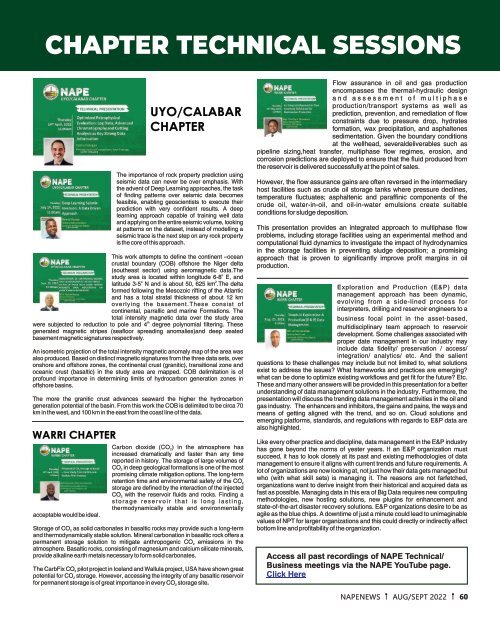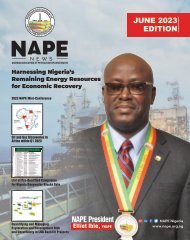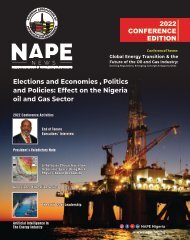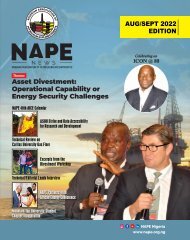You also want an ePaper? Increase the reach of your titles
YUMPU automatically turns print PDFs into web optimized ePapers that Google loves.
CHAPTER TECHNICAL SESSIONS<br />
This work attempts to define the continent –ocean<br />
crustal boundary (COB) offshore the Niger delta<br />
(southeast sector) using aeromagnetic data.The<br />
o<br />
study area is located within longitude 6-8 E, and<br />
o 2<br />
latitude 3-5 N and is about 50, 625 km .The delta<br />
formed following the Mesozoic rifting of the Atlantic<br />
and has a total stratal thickness of about 12 km<br />
overlying the basement.These consist of<br />
continental, parrallic and marine Formations. The<br />
total intensity magnetic data over the study area<br />
th<br />
were subjected to reduction to pole and 4 degree polynomial filtering. These<br />
generated magnetic stripes (seafloor spreading anomalies)and deep seated<br />
basement magnetic signatures respectively.<br />
An isometric projection of the total intensity magnetic anomaly map of the area was<br />
also produced. Based on distinct magnetic signatures from the three data sets, over<br />
onshore and offshore zones, the continental crust (granitic), transitional zone and<br />
oceanic crust (basaltic) in the study area are mapped. COB delimitation is of<br />
profound importance in determining limits of hydrocarbon generation zones in<br />
offshore basins.<br />
The more the granitic crust advances seaward the higher the hydrocarbon<br />
generation potential of the basin. From this work the COB is delimited to be circa 70<br />
km in the west, and 100 km in the east from the coast line of the data.<br />
WARRI CHAPTER<br />
acceptable would be ideal.<br />
UYO/CALABAR<br />
CHAPTER<br />
The importance of rock property prediction using<br />
seismic data can never be over emphasis. With<br />
the advent of Deep Learning approaches, the task<br />
of finding patterns over seismic data becomes<br />
feasible, enabling geoscientists to execute their<br />
prediction with very confident results. A deep<br />
learning approach capable of training well data<br />
and applying on the entire seismic volume, looking<br />
at patterns on the dataset, instead of modelling a<br />
seismic trace is the next step on any rock property<br />
is the core of this approach.<br />
Carbon dioxide (CO 2) in the atmosphere has<br />
increased dramatically and faster than any time<br />
reported in history. The storage of large volumes of<br />
CO 2 in deep geological formations is one of the most<br />
promising climate mitigation options. The long-term<br />
retention time and environmental safety of the CO 2<br />
storage are defined by the interaction of the injected<br />
CO 2 with the reservoir fluids and rocks. Finding a<br />
s t o r a g e r e s e r v o i r t h a t i s l o n g l a s t i n g ,<br />
thermodynamically stable and environmentally<br />
Storage of CO 2 as solid carbonates in basaltic rocks may provide such a long-term<br />
and thermodynamically stable solution. Mineral carbonation in basaltic rock offers a<br />
permanent storage solution to mitigate anthropogenic CO 2 emissions in the<br />
atmosphere. Basaltic rocks, consisting of magnesium and calcium silicate minerals,<br />
provide alkaline earth metals necessary to form solid carbonates.<br />
The CarbFix CO 2 pilot project in Iceland and Wallula project, USA have shown great<br />
potential for CO 2 storage. However, accessing the integrity of any basaltic reservoir<br />
for permanent storage is of great importance in every CO 2 storage site.<br />
Flow assurance in oil and gas production<br />
encompasses the thermal-hydraulic design<br />
a n d a s s e s s m e n t o f m u l t i p h a s e<br />
production/transport systems as well as<br />
prediction, prevention, and remediation of flow<br />
constraints due to pressure drop, hydrates<br />
formation, wax precipitation, and asphaltenes<br />
sedimentation. Given the boundary conditions<br />
at the wellhead, severaldeliverables such as<br />
pipeline sizing,heat transfer, multiphase flow regimes, erosion, and<br />
corrosion predictions are deployed to ensure that the fluid produced from<br />
the reservoir is delivered successfully at the point of sales.<br />
However, the flow assurance gains are often reversed in the intermediary<br />
host facilities such as crude oil storage tanks where pressure declines,<br />
temperature fluctuates; asphaltenic and paraffinic components of the<br />
crude oil, water-in-oil, and oil-in-water emulsions create suitable<br />
conditions for sludge deposition.<br />
This presentation provides an integrated approach to multiphase flow<br />
problems, including storage facilities using an experimental method and<br />
computational fluid dynamics to investigate the impact of hydrodynamics<br />
in the storage facilities in preventing sludge deposition; a promising<br />
approach that is proven to significantly improve profit margins in oil<br />
production.<br />
Exploration and Production (E&P) data<br />
management approach has been dynamic,<br />
evolving from a side-lined process for<br />
interpreters, drilling and reservoir engineers to a<br />
business focal point in the asset-based,<br />
multidisciplinary team approach to reservoir<br />
development. Some challenges associated with<br />
proper date management in our industry may<br />
include data fidelity/ preservation / access/<br />
integration/ analytics/ etc. And the salient<br />
questions to these challenges may include but not limited to, what solutions<br />
exist to address the issues? What frameworks and practices are emerging?<br />
what can be done to optimize existing workflows and get fit for the future? Etc.<br />
These and many other answers will be provided in this presentation for a better<br />
understanding of data management solutions in the industry. Furthermore, the<br />
presentation will discuss the trending data management activities in the oil and<br />
gas industry. The enhancers and inhibitors, the gains and pains, the ways and<br />
means of getting aligned with the trend, and so on. Cloud solutions and<br />
emerging platforms, standards, and regulations with regards to E&P data are<br />
also highlighted.<br />
Like every other practice and discipline, data management in the E&P industry<br />
has gone beyond the norms of yester years. If an E&P organization must<br />
succeed, it has to look closely at its past and existing methodologies of data<br />
management to ensure it aligns with current trends and future requirements. A<br />
lot of organizations are now looking at, not just how their data gets managed but<br />
who (with what skill sets) is managing it. The reasons are not farfetched,<br />
organizations want to derive insight from their historical and acquired data as<br />
fast as possible. Managing data in this era of Big Data requires new computing<br />
methodologies, new hosting solutions, new plugins for enhancement and<br />
state-of-the-art disaster recovery solutions. E&P organizations desire to be as<br />
agile as the blue chips. A downtime of just a minute could lead to unimaginable<br />
values of NPT for larger organizations and this could directly or indirectly affect<br />
bottom line and profitability of the organization.<br />
Access all past recordings of NAPE Technical/<br />
Business meetings via the NAPE YouTube page.<br />
Click Here<br />
NAPENEWS AUG/SEPT <strong>2022</strong> 60










